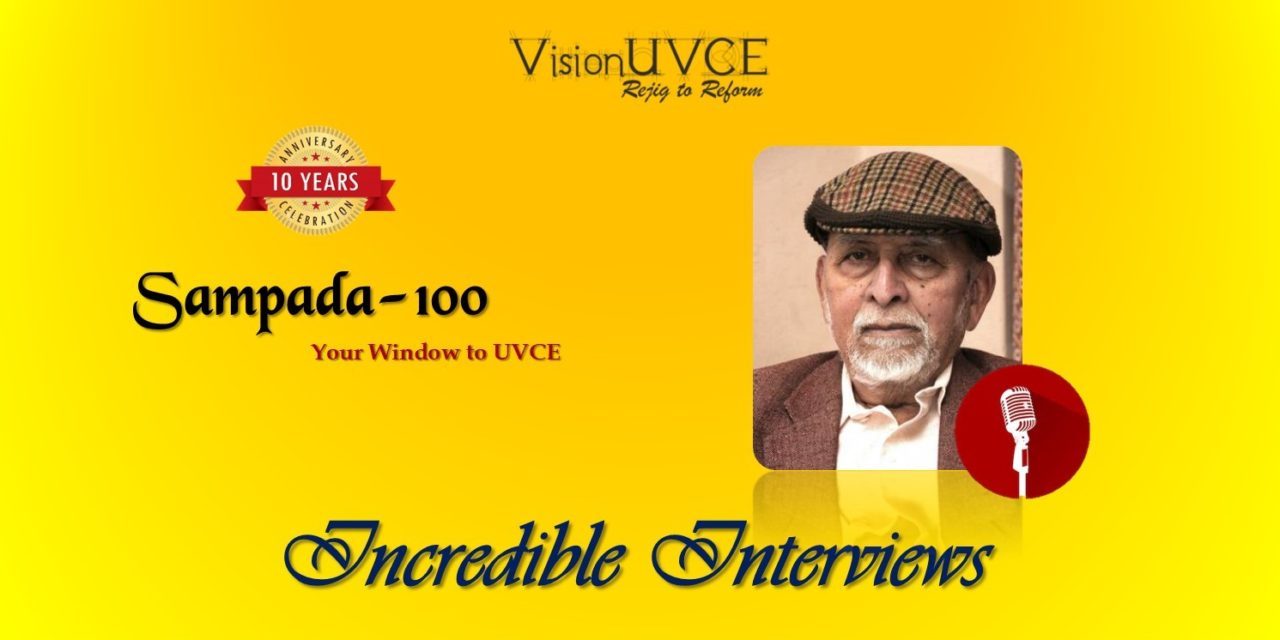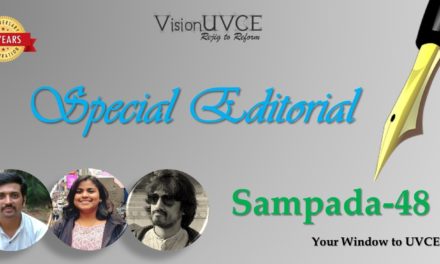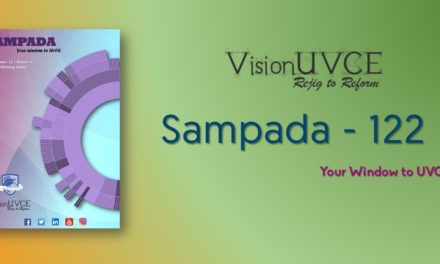Borrowed from SAMPADA old editions – for the 10th Anniversary Special Issue – Interviews section. This one is of Dr M R Srinivasan, 1950 Mech.
Team Sampada had the privilege to meet Dr. M R Srinivasan, namma UVCE Alumni—Batch of 1950 Mechanical Engineering who is a Nuclear Scientist. He played a key role in the development of India’s nuclear power programme and the development of the PHWR. He is a recipient of Padma Bhushan in 1990, Padma Vibhushan in 2015, Padma Shri in 1984. The interview was a great learning for the team personally. Here are some excerpts from the interaction:
Team Sampada: The most memorable memories from your college days that you reminisce even today.
Dr. MR Srinivasan : The most memorable event during my time in college was an ‘open-house’ we had. It was probably in my third year (1948) or fourth year (1949). The college opened its doors to the general public for a full day. Most of the visitors were parents and family members of the students. I was the volunteer explaining the Mirrlees and Watson Steam Engine. This single vertical cylinder steam engine attracted the attention of all visitors because of the huge fly wheel. The engine delivered only a small amount of energy. The college ran it for just a few days in the year, when the steam boiler plant was fired with coal. I took great delight in explaining all the components of the engine. By 1948-49, steam turbines had replaced steam reciprocating engines in many power plants around the world. The reciprocating engine continued to function in old factories or old ships. We had big crowds taking interest in this old fashioned engine. Another attraction was the artificial lightning produced by high voltage discharge, in the electrical laboratory.
Team Sampada: It would be great if you can share your memories of the faculty present during your college time and how their teaching impacted you in your career.
Dr. MR Srinivasan : Our batch had very good faculty members in all disciplines. In the civil engineering faculty, we had C Gopalakrishna who was very meticulous and kind hearted. He taught us engineering materials and structural engineering. In the mechanical branch we had Patankar, Gundu Rao and B P Gopalakrishna, in the first three years. Patankar had a great sense of humor and joked much of the time. B P G was superb in drawing free hand complex machine elements on the black board. Gundu Rao was a kind human being. In the fourth year, the mechanical branch had many courses given by B R Narayana Iyengar, who had returned to India, after spending two years in the US. Batni Prahalada Rao was also a very good teacher in electrical machine design. We cannot forget Mruthyunjayem, our drafting teacher who drilled into developing good drafting habits, in the first two years. Our teachers in physics and mathematics also were very good. We owe the good foundations of our learning to those great teachers.
Team Sampada: How was your journey as an engineer when compared to the times now where there are more industry opportunities and technological advancements?
Dr. MR Srinivasan : Nowadays, industry offers many interesting career options. In our time, in India, only government departments and public sector undertakings were the important employers. In the post-independence period, India embarked on new ventures such as building hydro and thermal power stations, steel plants, machine tool manufacturing and so forth. These opportunities enabled us many of us to get good industry experience, in areas that were new in India. While in recent years, many engineering graduates went to the information technology and computer fields, in our time, we engaged ourselves in the more basic infrastructural development.
Team Sampada: Winning the Padma Vibhushan award, how do you describe the journey that led to receiving that great honor?
Dr. MR Srinivasan : The Padma Vibhushan Award, came to me after many years of work in the field of nuclear technology. I received Padma Shri award when I was 54 years, the Padma Bhushan award when I was 60 years and finally the Padma Vibhushan when I was 85 years! It has been a long and exciting journey and the awards I have received are based on the work of large teams of engineers, scientists and technicians whom I was privileged to lead.
Team Sampada: When you visited college after a long time, what are the things that crossed your mind?
Dr. MR Srinivasan : I visited UVCE some fifty years after graduation. I found the familiar heritage building and the library but was disappointed to note that the building space, laboratories, especially the equipment and workshops had not undergone any significant modernization. Considering the rapidity with which technology has progressed in the last five or six decades, UVCE has not risen to the extent it should have to impart instruction in the latest areas of technology. I cannot but help feeling that collectively the Karnataka Government, the university and the UVCE leadership have not modernized the institution in keeping with the times. The concerned agencies have been happy to carry on pretty much in the old ways! From now on atleast, we must all do whatever we can to transform UVCE into an institution that will train people to solve the problems Karnataka and India will face in the twenty first century, in many technological areas.
Team Sampada: As students and Alumni what are the small things we can trigger to bring about a change?
Dr. MR Srinivasan : Alumni living in and around UVCE can catalyze the students to interact strongly with industry and application areas. UVCE faculty and student groups should invite alumni engaged in the practice of engineering to conduct seminars where by the students interact with practicing engineers, frequently and intimately.
Team Sampada: In your vision, how should UVCE be shaped so that it can stay relevant for the next 100 years and impart knowledge to students & motivate them consistently?
Dr. MR Srinivasan : There are many problems our society in facing such as climate change, air and noise pollution, traffic management, waste water recycling, solid waste recycling, employment generation, keeping our industries competitive in the global markets, energy efficiency, materials use efficiency, developing new material combinations, low cost and energy efficient residences and so forth. These are all engineering problems that affect the well-being of society. The UVCE. Through its faculty and students should take active part in evolving solutions to these and similar problems. We must train more and more of our students to be entrepreneurs and business leaders creating jobs and wealth for the nation.
Team Sampada: From your point of view, how do you think UVCE has contributed to the technological advancement in the past 100 years? How has it contributed to the society overall?
Dr. MR Srinivasan : UVCE has certainly contributed significantly to training young men and women to become successful engineers, serving India and some of the other countries also with great distinctions. For the future while we will continue to train engineers of good quality, UVCE must also become a centre of research and development in many branches of engineering.
– Dr M R Srinivasan, Sampada 100





